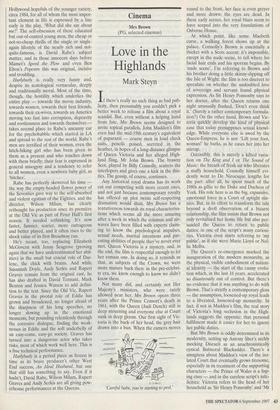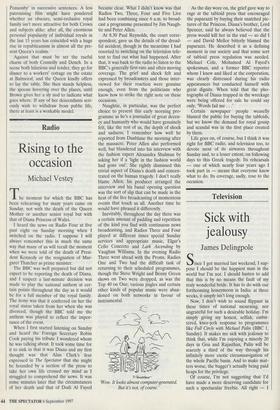Cinema
Mrs Brown
(PG, selected cinemas)
Love in the Highlands
Mark Steyn
If there's really no such thing as bad pub- licity, then presumably you couldn't pick a better week to release a film about a royal scandal. But, even without a helping hand from fate, Mrs Brown seems designed to invite topical parallels. John Madden's film even had the mid-19th century's equivalent of paparazzi — coarse men in loud check suits, pencils poised, secreted in the heather, in hopes of a long-distance glimpse of Queen Victoria and her alleged High- land fling, Mr John Brown. The brawny Scot, played by Billy Connolly, scatters the interlopers and gives one a kick in the this- tles. The gossip, of course, continues.
Any historical royal drama has its work cut out competing with more recent ones, and not just because contemporary royalty has offered up plot twists self-respecting dramatists would shun. Mrs Brown has a tentativeness towards its royal characterisa- tions which seems all the more amazing after a week in which the columns and air- waves have been filled with experts claim- ing to know the psychological impulses, sexual needs, marital intentions and par- enting abilities of people they've never ever met. Queen Victoria is a mystery, and, in the end, the film is respectful enough to let her remain one. In doing so, it reminds us that, as subjects of the Crown, we were more mature back then: in the pre-celebri- ty era, we knew enough to know we didn't know them.
Not many did, and certainly not Her Majesty's ministers, who were rarely allowed near her. Mrs Brown opens three years after the Prince Consort's death in 1861, with the Queen (Judi Dench) still in deep mourning and everyone else at Court sunk in deep gloom. Our first sight of Vic- toria is the back of her head, the grey hair drawn into a bun. When the camera moves `Careful babe, you're starting to peel.' round to the front, her face is even greyer and more drawn; the eyes are dead. In these early scenes, her royal blues seem to have seeped into the very foundations of Osborne House.
At which point, like some Macbeth curse, a walking forest shows up at the palace. Connolly's Brown is essentially a thicket with a Scots accent: it's impossible, except in the nude scene, to tell where his facial hair ends and his sporran begins. By `nude scene', I'm referring to Brown and his brother doing a little skinny-dipping off the Isle of Wight: the film is too discreet to speculate on whether the undoubted love of sovereign and servant found physical expression. As Sir Henry Ponsonby says to her doctor, after the Queen returns one night unusually flushed, 'Don't even think it.' (Surely a rather contemporary formula- tion?) On the other hand, Brown and Vic- toria quickly develop the kind of physical ease that today presupposes sexual knowl- edge. While everyone else is awed by the Queen-Empress, he is not: 'Lift your foot, woman!' he barks, as he eases her into her stirrup.
Ostensibly, this is merely a kilted varia- tion on The King and I or The Sound of Music: the breath of fresh air who liberates a stuffy household. Connolly himself evi- dently went to De Niroesque lengths for the part: after all, he spent much of the 1980s as gillie to the Duke and Duchess of York. His role here is as the big, expansive, emotional force in a Court of uptight nin- nies. But, in its effort to transform the tale beyond a droll observation of a bizarre relationship, the film insists that Brown not only revitalised her home life but also per- suaded the Queen to return to public duties: in one of the script's many curiosi- ties, Victoria even starts referring to 'my public', as if she were Marie Lloyd or Nel- lie Melba.
The Queen's re-emergence marked the inauguration of the modern monarchy, as the physical, visible embodiment of nation- al identity — the start of the canny evolu- tion which, in the last 16 years, accelerated so disastrously out of control. But there's no evidence that it was anything to do with Brown. That's strictly a contemporary gloss — the assumption, loosened-up royal leads to a liberated, loosened-up monarchy. In fact, if not in Madden's film, the real story of Victoria's long seclusion in the High- lands suggests the opposite: that personal fulfilment made it easier for her to ignore her public duties.
But Mrs Brown is oddly determined in its modernity, setting up Antony Sher's archly mocking Disraeli as an anachronistically cynical Balmoral Blackadder. There's a smugness about Madden's view of the iso- lated Court that eventually grows tiresome, especially in its treatment of the supporting characters — the Prince of Wales is a lisp- ing cissy — and in the careless script's infe- licities: Victoria refers to the head of her household as 'Sir Henry Ponsonby' and 'Mr Ponsonby' in successive sentences. A less patronising film might have pondered whether an obscure, semi-reclusive royal family isn't more attractive for both Crown and subjects alike: after all, the enormous personal popularity of individual royals in the last 15 years has coincided with a huge rise in republicanism in almost all the pre- sent Queen's realms.
Against that must be set the rueful charm of both Connolly and Dench. In a scene both hilarious and tender, they go for dinner to a workers' cottage on the estate at Balmoral, and the Queen kindly offers to lay the table. She then stands helpless, the spoons hovering over the places, until Brown gives her a sly nod to indicate what goes where. If any of her descendants seri- ously wish to withdraw from public life, there at least is a workable model.



























































 Previous page
Previous page